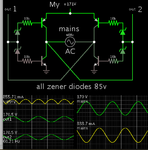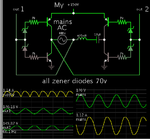T
treez
Guest
Hello,
I have done this “poor-person’s” Grid Tied Inverter simulation in LTspice. (Schematic and LTspice simulation are attached, waveform of current supplied back into the mains is also attached)
It puts power back into the mains.
Admittedly, the current waveform is not sinusoidal, though it does have a decent power factor.
The thing is, surely it is not so absolutely massively important for a Grid Tied Inverter to have a purely sinusoidal output waveform? After all, the duty of drawing sinusoidal, in-phase current from the mains rests with the loads, not the inverters. ..And a great many of the loads on the mains draw non-sinusoidal mains current (eg sub 75W SMPS’s in the EU). If all of the loads on a particular mains phase are drawing non-sinusoidal current, then a pure-sinusoidal inverter for that particular phase is a waste of time…….because it simply will not be able to deliver sinusoidal current into that particular mains phase.
So do you agree, that the attached H Bridge inverter is of some good (admittedly not perfect) and can play a role in energy saving by pushing power back into the mains from eg a renewable source?
- - - Updated - - -
Also,
If you do object to the previous version of the H Bridge grid tied inverter,(due to its lack of sinusoidal current) then does the following one please you?...
This H bridge grid tied inverter (attached) pumps a sinusoidal current back into the mains….however it simply does this by having a sinusoidal reference voltage into its pwm controller….there is absolutely none of the complicated control software which exists in all the microcontroller solutions for grid tied inverters. This is an extremely simple grid tied inverter. Admittedly, it is devoid of the rather faster dynamic feedback loop of the usual software based GTI solutions…but in all truth, as long as somebody on the same mains phase is drawing more power than this simple H bridge is pumping back into the mains, then it will operate perfectly well.
So what’s wrong with it?
Why is there a need for GTI’s with reams of complex software control algorithms?
Attached please find the LTspice schematic, schematic and current waveform of this “simple sinusoidal grid tied inverter”
I have done this “poor-person’s” Grid Tied Inverter simulation in LTspice. (Schematic and LTspice simulation are attached, waveform of current supplied back into the mains is also attached)
It puts power back into the mains.
Admittedly, the current waveform is not sinusoidal, though it does have a decent power factor.
The thing is, surely it is not so absolutely massively important for a Grid Tied Inverter to have a purely sinusoidal output waveform? After all, the duty of drawing sinusoidal, in-phase current from the mains rests with the loads, not the inverters. ..And a great many of the loads on the mains draw non-sinusoidal mains current (eg sub 75W SMPS’s in the EU). If all of the loads on a particular mains phase are drawing non-sinusoidal current, then a pure-sinusoidal inverter for that particular phase is a waste of time…….because it simply will not be able to deliver sinusoidal current into that particular mains phase.
So do you agree, that the attached H Bridge inverter is of some good (admittedly not perfect) and can play a role in energy saving by pushing power back into the mains from eg a renewable source?
- - - Updated - - -
Also,
If you do object to the previous version of the H Bridge grid tied inverter,(due to its lack of sinusoidal current) then does the following one please you?...
This H bridge grid tied inverter (attached) pumps a sinusoidal current back into the mains….however it simply does this by having a sinusoidal reference voltage into its pwm controller….there is absolutely none of the complicated control software which exists in all the microcontroller solutions for grid tied inverters. This is an extremely simple grid tied inverter. Admittedly, it is devoid of the rather faster dynamic feedback loop of the usual software based GTI solutions…but in all truth, as long as somebody on the same mains phase is drawing more power than this simple H bridge is pumping back into the mains, then it will operate perfectly well.
So what’s wrong with it?
Why is there a need for GTI’s with reams of complex software control algorithms?
Attached please find the LTspice schematic, schematic and current waveform of this “simple sinusoidal grid tied inverter”
Attachments
-
H bridge grid tied inverter.txt8.4 KB · Views: 51
-
H Bridge inverter schematic.pdf18.2 KB · Views: 110
-
 Mains voltage and inverter current.jpg107.8 KB · Views: 75
Mains voltage and inverter current.jpg107.8 KB · Views: 75 -
H Bridge inverter _sinusoidal current _schematic.pdf20.1 KB · Views: 126
-
H bridge grid tied inverter_sinusoidal current.txt10.8 KB · Views: 56
-
 Mains voltage and inverter _sinusoidal current.jpg108 KB · Views: 79
Mains voltage and inverter _sinusoidal current.jpg108 KB · Views: 79

